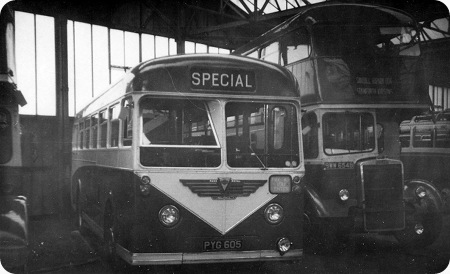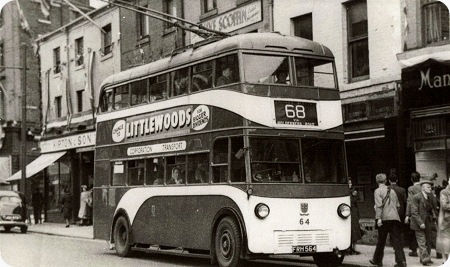York Pullman – AEC Regent III – JDN 669 – 65
York Pullman Bus Company Ltd
1954
AEC Regent III 6812A
Roe H33/25RD
The last in my collection of York Pullman vehicles, that’s worth showing that is, shot into sun again, apart from having my finger in front of the lens I couldn’t have got it more wrong. Anyway this shot does show off York Pullmans distinctive livery, there was a darker yellow band below the windows unfortunately the upper band does not show very well in this shot. York Pullman took delivery of three of these Regent IIIs in 1954 JDN 667-9 fleet numbers 63-5 fortunately number 64 was restored by Tony Peart to a very high standard and on his death passed to the Lincolnshire Vintage Vehicle Society.
A full list of Regent III codes can be seen here.
———
Chassis, body, operator – almost perfection. [Well you know I prefer heavy weight AECs – or heavy anything, come to that!] …..and if my bad photos turned out like this one I’d be very happy.
David Oldfield
———
A very handsome vehicle in a very handsome livery, and the shadow cast by the sun shows the waist rail up a treat. For anyone interested, there is a video clip on ‘you tube’ aboard 64 (JDN 668), touring around Lincoln. Whilst watching and listening to this, I could not help thinking that the gearbox sounds were very similar to those of pre-war AECs. Was the gearbox of prewar design by any chance, or a modified version perhaps?
Brendan Smith
———
I suspect the aural beauty of all manual AEC boxes lay in their pre-war origins.
David Oldfield
———
I would also like to associate myself with the affection expressed for the music of the AEC manual gearbox. My early recollections are of Midland General specimens (including some pre-war front entrance Regents), various Trent examples, and later Grimsby’s ex-London Transport STLs. Just a few weeks ago I had the enjoyment of the same sounds on a preserved Regal/Strachans during the Kingsbridge 7ft 6in running day – all the way from Kingsbridge to Totnes and back – a hilly run with plenty of second and even first gear work.
Stephen Ford
———
Yet another vote here for the glorious sounds of the AEC manual gearboxes. The much travelled and totally rebuilt example that we had at Samuel Ledgard’s (FJW 938) was a fine example of the original sounds with further fascination from a good deal of wear – originally a Birmingham Corporation Regent 1 it arrived with us as a "Regal" coach with Burlingham bodywork (the rebuilding by Don Everall of Wolverhampton). It was a joy to work on but its raucous subtleties (if that’s not a contradiction in terms) didn’t filter through to the passengers – their loss of course !! When the new Regent Vs arrived further aural delights were to be enjoyed. These fine vehicles had a rather higher pitched and "purer" sound which disguised the already civilised and quiet 9.6 litre engines somewhat and gave a distinct "petrol" impression – those senior ones among us have experienced some glorious times which are not to be had on service work today.
Chris Youhill
———
Oh Chris. Don’t get me started again about STD Regents on the hills of Sheffield and Derbyshire!
David Oldfield
———
The place to stand, if I recall hazy memories, was the middle of Shude Hill in Sheffield as the many buses climbed towards High Street. The AEC’s, especially the "big bore" Regent V’s would blast hot exhaust across the central island, but the III’s would sometimes seem to have what we boy racers would call valve bounce. As for the tin-front Titans- was it more a sort of strangled wheeze? That may be inaccurate, but I do remember one Regent going up at full chat and a man saying to a woman next to me "that’ll singe tha nylons luv"!
Joe
——— Top of this posting ———



